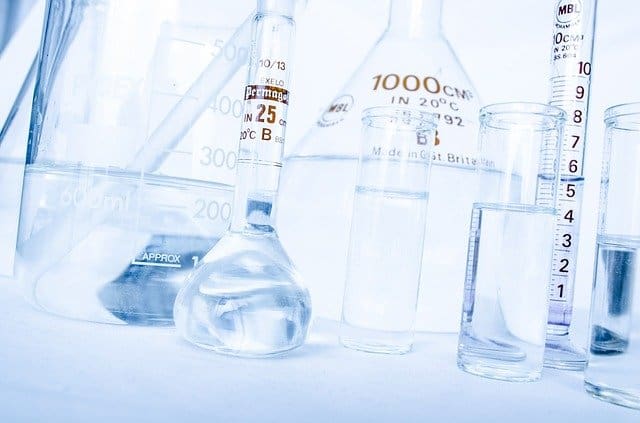Major Differences Between Acids And Bases

The difference between acid and base lies in their definition, characteristics, and uses. For example, an acid is a substance that interacts with water to produce hydroxonium ions (H3O+) in an aqueous solution while a base is a substance that interacts with water to produce hydroxide ions (OH-) in an aqueous solution. Also according to Bronsted-Lowry theory, define an acid as proton donor and a base as proton acceptor.
There are 3 important theories about acids and bases. These are Arrhenius theory, Bronsted-Lowry theory, and the Lewis theory.
What is An Acid?
An acid is a substance that interacts with water to produce hydroxonium ions (H3O+) in an aqueous solution. The hydroxonium ions are formed as a result of the chemical bonding between the oxygen of water molecules and the protons released by the acid due to its ionization.
There are two types of acid; strong acid and weak acid.
A strong acid is one that ionizes completely in solution. Examples are Hydrochloric acid (HCl), Tetraoxosulphate (IV) acid (H2SO4), Trioxonitrate (V) acid (HNO3), etc.
A weak acid is one that ionizes slightly in solution. Examples are Hydroflouric acid (HF), Ethanoic acid (CH3COOH), Trioxocarbonate(IV) acid (H2CO3), etc.
What is A Base?
A base is a substance that interacts with water to produce hydroxide ions (OH-) in an aqueous solution. Bases are certain metallic oxides, metallic hydroxide, and aqueous ammonia. Bases are also conductors of electricity in aqueous solution because of their ability to ionize.
There two type of bases; strong and weak base. Examples of bases are Sodium hydroxide (NaOH), Ammonium hydroxide (NH4OH), Potassium hydroxide (KOH), etc.
Differences between acid and base [in their definition]
- According to Bronsted-Lowry theory, define an acid as proton donor while a base as proton acceptor.
- According to Lewis theory, acid is an electron pair acceptor while a base is an electron pair donor
Differences between acids and bases in their Characteristics
They can be differentiated based on their characteristics.
Acids
- It has a PH less than 7
- Their dilute solution has a sour taste
- Most of the common acids react with highly electropositive metals to liberate hydrogen
- Some of the acids have corrosive action, that is, burning effects on skin
- Acids react with trioxocarbonate (IV) salts and hydrogentrioxocarbonate (IV) salts to liberate carbon (IV) oxide
Bases
- The aqueous solutions of many of bases have bitter taste
- The aqueous solutions of bases have soapy taste
- Their aqueous solutions have a PH greater than 7
- A basic solution changes the color of litmus from red to blue and the color of phenolphthalein from colorless to red
Read: Expected topics in JAMB chemistry
Uses of Acids and Bases
They can be differentiated based on their uses.
Uses of Acids
- It is applied to remove deposits from the inside of the boilers.
- It is used for cleaning sinks and sanitary ware.
- It is used in car batteries.
- It is used in the manufacture of paints, drugs, dyes, and to produce fertilizers.
Uses of Bases
- Soap industry for soap making.
- For liming of soil against hyperacidity.
- Making antacids for the stomach or to prepare antidotes for acid poisoning.
In conclusion, I hope I have answered your question on what is the difference between acid and base.
